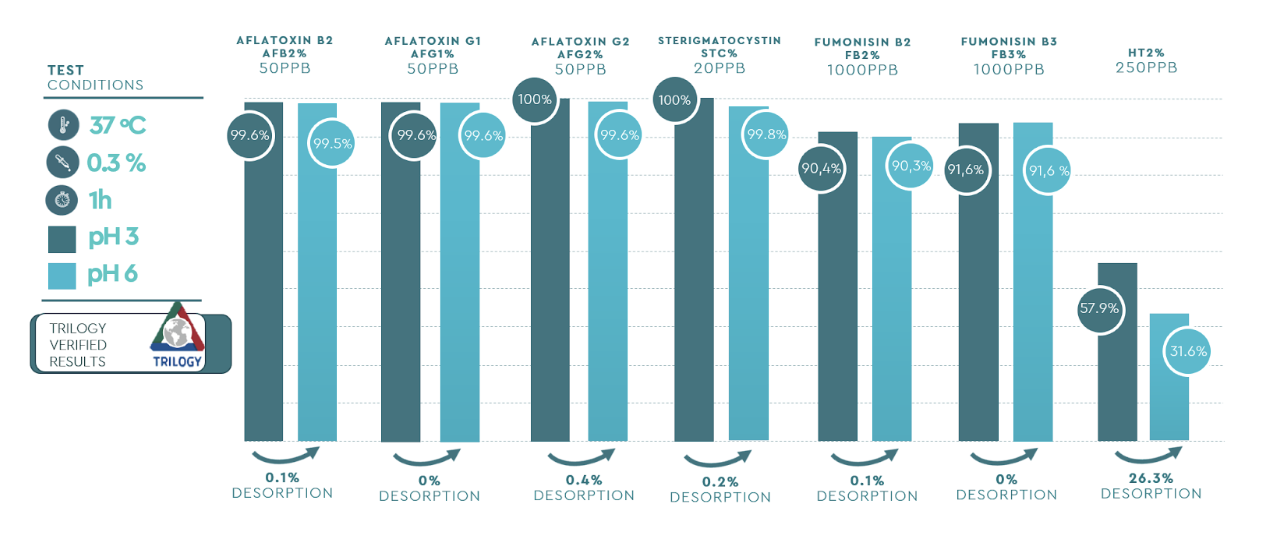In the world of animal nutrition, mycotoxins, toxic secondary metabolites produced by certain fungi, pose significant risks to animal health and livestock productivity. In a previous article we described the efficacy of BIŌNTE® QUIMITOX® PLUS against Aflatoxin B1 (AFB1), Fumonisin B1 (FB1), T-2 Mycotoxin (T-2), Ochratoxin A (OTA) and Zearalenone (ZEN). For this reason, in this article, we have thoroughly explored the major mycotoxins of concern, including Aflatoxins (AFB2, AFG1, AFG2) and Sterigmatocystin (STC) as a precursor, Fumonisins (FB2, FB3) and trichothecenes (HT-2 toxin), along with their detrimental effects on animal health and the efficacy of BIŌNTE® QUIMITOX® PLUS in their mitigation.
BIŌNTE® QUIMITŌX® PLUS – A triple action anti-mycotoxins solution
BIŌNTE presents BIŌNTE® QUIMITŌX® PLUS, a revolutionary anti-mycotoxins solution with triple action. Its unique combination of ingredients offers adsorption, bioprotection, and post-biotic effects, providing an effective, selective, and rapid response to mycotoxin challenges in animals.
In Vitro Trial: Evaluating BIŌNTE® QUIMITŌX® PLUS against multiple mycotoxins
Based on the results of our previous in vitro trial, where BIŌNTE® QUIMITOX® PLUS showed a binding capacity of up to 99% for AFB1, FB1, ZEN, OTA and mycotoxin T2, an in vitro trial was conducted at Trilogy Lab (USA), a well-known laboratory in the mycotoxin analysis industry. The aim of the trial was to evaluate the binding capacity of BIŌNTE® QUIMITŌX® PLUS for several mycotoxins, including aflatoxins (AFB2, AFG1, and AFG2), sterigmatocystin (STC), fumonisins (FB2 and FB3) and trichothecenes (HT-2 toxin). High-pressure liquid chromatography with tandem mass spectrometry (HPLC-MS/MS) was employed to determine the efficacy of the product, simulating the gastrointestinal tract conditions (at pH 3 and pH 6).
Aflatoxins – Persistent contaminants in animal feeds
Aflatoxin B2 (AFB2): produced by Aspergillus flavus, was first isolated from milled wheat cultures. The chemical structure of the compound was determined as dihydroaflatoxin B1. Biological activity include reduction of liver growth and size and extent of bile duct hyperplasia.
Aflatoxin G1 (AFG1): originating by the same strain of AFB1 and AFB2, this mycotoxin is one of the most common sources of contamination in cereals and feedstuffs, which has the highest incidence of lung and esophageal cancer.
Aflatoxin G2 (AFG2): probably the less harmful mycotoxin of this group. It can contaminate a range of food crops, such as peanuts, maize, rice and nuts, especially in warm, humid regions where mould growth is more prevalent. Aflatoxin G2, like other aflatoxins, poses significant health risks when ingested or inhaled, as it can cause liver damage, suppress the immune system.
Sterigmatocystin (STC): discovered in 1954, and produced by Aspergillus versicolor, represent a precursor of AFB1, when cereals or food are contaminated with fungi with the ability of producing aflatoxins. It is considered a potent carcinogen, mutagen, and teratogen. Ruminants species are especially sensitive to this toxin.
BIŌNTE® QUIMITŌX® PLUS exhibited remarkable efficacy in completely binding AFB2, AFG1, and AFG2, with over 99% adsorption, along with high effectiveness for sterigmatocystin (STC), a precursor of aflatoxins (see Figure 1).
Fumonisins – Corn’s Hidden Threat
Fumonisin (FB2): originating by the same strain of FB1, this toxin can occur at about 30% of FB1 in naturally-contaminated corn, and is generally considered to be equitoxic to FB1. It can induce: hepatic necrosis, biliary hyperplasia, atrophy of the thymus cortex and cytotoxic effect on erythrocytes and lymphocytes.
Fumonisin (FB3): this toxin represents the less toxic of this group, although closely mimic the toxicological and cancer initiating activity of FB1 and thus could contribute to the toxicological effects of the fungus in animals.
BIŌNTE® QUIMITŌX® PLUS demonstrated significant binding efficacy, adsorbing 90% of FB2, and 92% of FB3. At the intestinal level, high effectiveness was observed for FB2 and FB3. (see Figure 1).
HT-2 Toxin – A Double Threat to Livestock
HT-2 Toxin, produced by Fusarium species, are commonly present in cereals and forages. The toxic effects of these trichothecenes lead to reduced feed intake and weight loss in animals.
BIŌNTE® QUIMITŌX® PLUS exhibited remarkable efficacy, adsorbing 58% of HT-2 Toxin (see figure 1)
As showed in Figure 1, BIŌNTE® QUIMITŌX® PLUS allow to control most of the mycotoxins in animal nutrition.

Figure 1. Efficacy of BIŌNTE® QUIMITŌX® PLUS
BIŌNTE® QUIMITŌX® PLUS offers a powerful and 100% natural solution to mitigate mycotoxin hazards in animal nutrition. Its triple action formula ensures optimal mycotoxin management, protecting animal health and promoting resilient livestock production. Implement BIŌNTE® QUIMITŌX® PLUS to secure a healthier future for animals and bolster the livestock industry’s productivity in the face of mycotoxin challenges.



